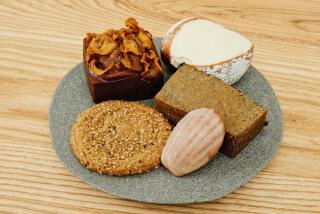Tea: Steeping in Seattle
SEATTLE — This city is so caffeinated you can hardly blame an outsider for viewing it as a rainy-day parade of Starbucks, the coffee-chain colossus that began here.
Java shops large and small rule Seattle, but, if the personnel shake-ups at two of its coffee kings are any indication, a backlash of sorts may be brewing. Seattle-based java giant Tully’s Coffee announced the resignation of five top executives, including its chief executive; on Feb. 21, Starbucks announced that 600 jobs would be cut, including about 70 in the city, a move that comes on the heels of the ouster and replacement of its chief executive.
Whether these moves mean Seattleites are turning away from their favorite pick-me-up is still unknown. But one purveyor of another hot beverage thinks the pendulum is swinging in a new direction, however slowly.
Jeannie Liu, owner of the 6-month-old Miro Tea, a sleek, ultramodern establishment that offers more than 200 varieties, says there’s a citywide movement toward the beverage exalted from London to Beijing.
She predicts a boom in tea drinking within five years in Seattle, as the cosmopolitan city with a heavy international influence becomes home to more teahouses and stores devoted to it.
“This is a community that is accustomed to drinking hot beverages,” she says. “There are tons and tons of tea drinkers. It’s just that coffee has gotten a lot more attention.”
Part of tea’s growing appeal lies in the ritualistic, communal experience of drinking it. At Miro, in Seattle’s Ballard district, once you order, say, Heaven’s Dew (a green tea with a nutty-earthy taste) or Red Mint (a powerfully constructed breath-freshening blast), it is served in a glass teapot set over a burning candle that keeps it hot. You don’t remove the strainer and pour a cup until the digital timer your server provides goes off, indicating that the leaves have steeped long enough. Meanwhile, you can play one of the many board games on hand, kick back and chat with friends or, of course, surf with Wi-Fi.
In many ways, Teahouse Kuan Yin, which opened in 1990 in the University of Washington district, is the antiquated antithesis of Miro.
Here, the timer is a mini-hourglass and the homey interior is cluttered with tables and chairs, artwork and shelves stacked with tea-drinking accessories. It’s like stepping into someone’s personal library of leather-bounds.
Owner Marcus A. Gramps downplays his tea-scholar credentials (he’s a practicing psychotherapist), especially when compared with the store’s original proprietors, who instituted the no-cellphone policy still enforced today. But Gramps is doing a good job of maintaining Kuan Yin’s rep as a tea drinkers’ jewel.
The Hot Pink Chai, served in a cup as big as a soup bowl and requiring a spoon to keep the film from collecting on its bright surface, is as mild and milky as the ice-cold Jasmine Lemonade is tart and tangy. Both are made from recipes unique to Kuan Yin.
Jan Johnson’s fingerprints are all over her baby too, Japantown’s multilevel Historic Panama Hotel Tea & Coffee House. Unlike Miro or Kuan Yin, which serve hundreds, the Panama pours only 28, all of which, from white to black, are stored in glass jars lining the counter.
What the Panama lacks in variety, however, it makes up for in history. As soon as your foot hits the hardwood of the early 20th century building, you get a sense of the past, audible in the creak of the chairs when you sit down with a steaming cup of black tea and visible in the black-and-white photos on the brick wall. “My first reason for buying the building was to save it for history,” says Johnson, who purchased it in 1985, eventually renovating it and, in the process, bringing it to life.
For those who prefer their tea free of muss and fuss, the British Pantry gives patrons a pared-down experience, much as you’d find in Manchester, England.
“This is a traditional tearoom,” Alvia Redman says of her family’s nearly 30-year-old restaurant in Redmond, outside Seattle.
A quick glance at the menu reveals only a handful of teas, but, as your server will inform you in a British accent, the restaurant probably has pretty much anything you can think of. Just ask. That said, joining the British Pantry’s many English customers with a piping-hot pot of standard breakfast tea or afternoon tea, which runs from 2:30 to 4:30 p.m., and snacking on a cucumber-and-cream-cheese sandwich or a scone, may make you want to affect a “My Fair Lady” voice and say things like “mum” and “cheerio.”
Behold the power of tea.
More to Read
Eat your way across L.A.
Get our weekly Tasting Notes newsletter for reviews, news and more.
You may occasionally receive promotional content from the Los Angeles Times.










